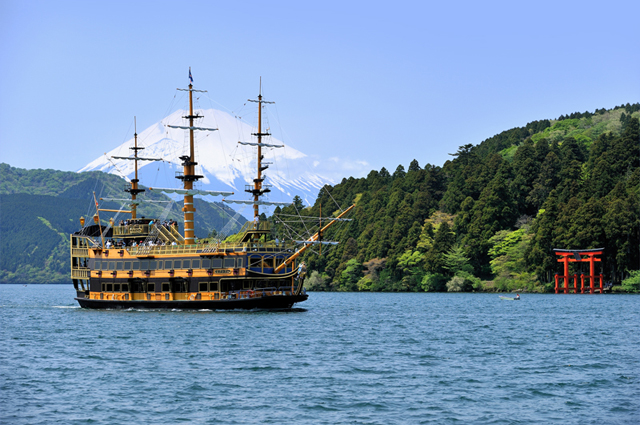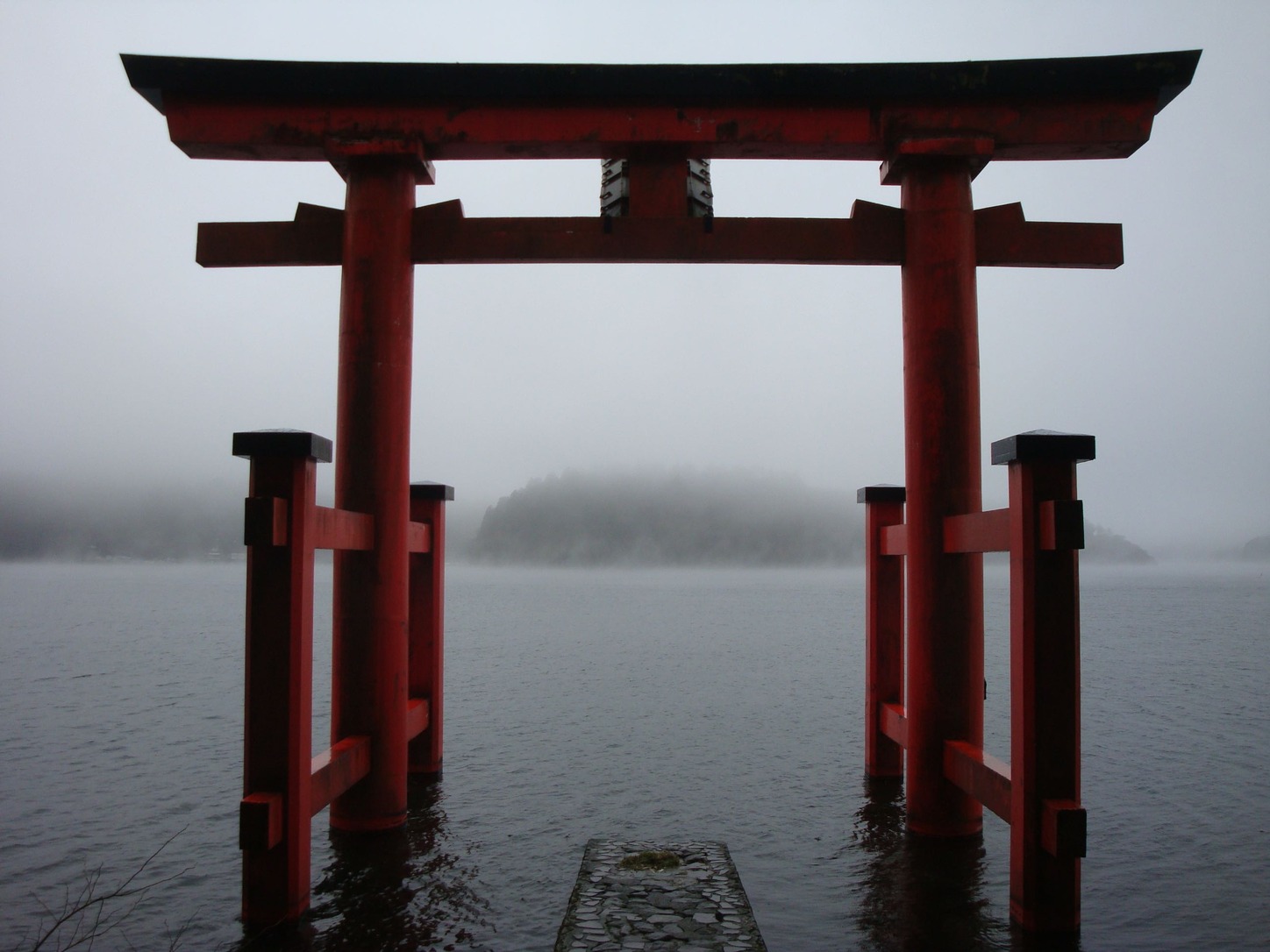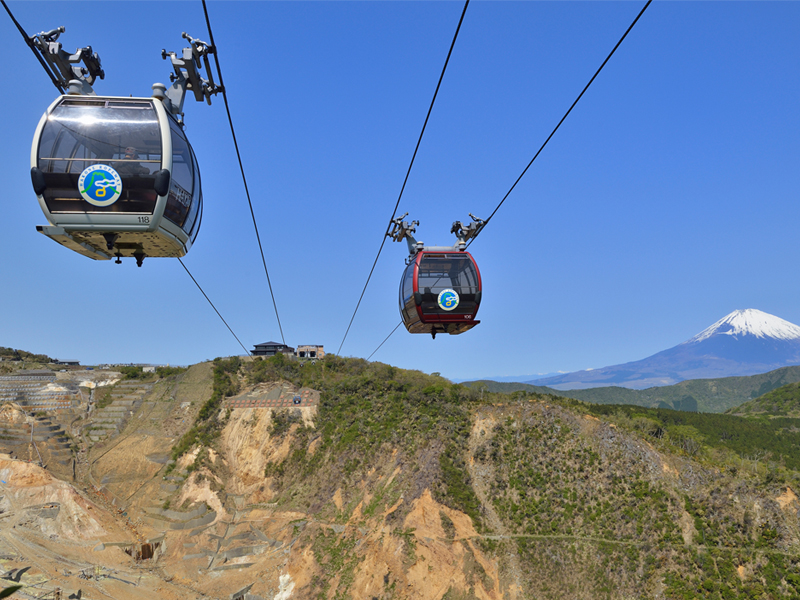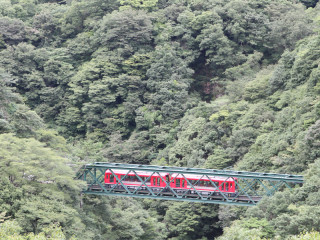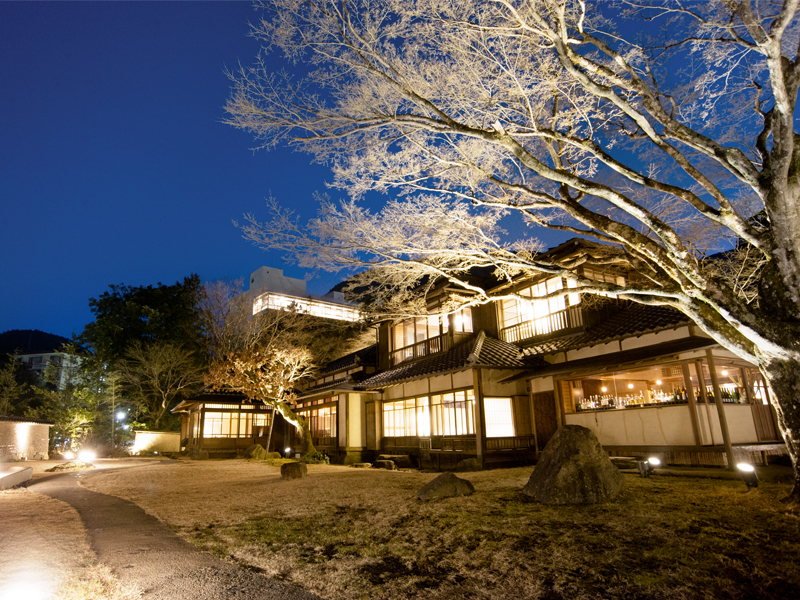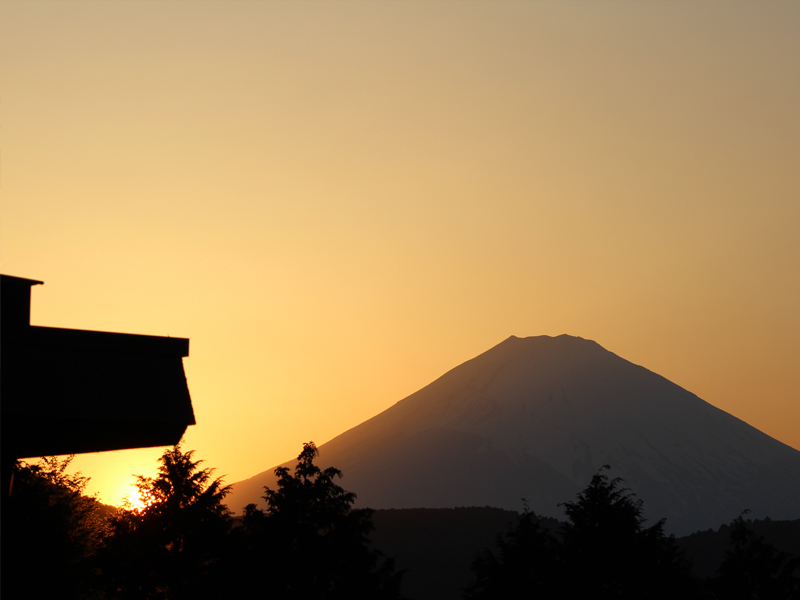Fewer than than two hours away from Tokyo’s hustle and bustle, Hakone has been attracting visitors for more than a thousand years. Some knew of Hakone for the impressive shrine that lies on the southeastern shore of Ashi-no-ko (Lake Ashi), but even more people were drawn to the region’s plentiful hot springs, powered by the geologic activity that has sculpted the varied landscape of the region.
by Alec Jordan
During the Edo period, Hakone was a primary way station along the Tokaido Road, the most well known of the “highways” that the daimyo (feudal rulers) of Japan’s historical provinces used to travel between Edo, as Tokyo was then known, and other parts of the country. The daimyo were required to come to the capital once a year, and as a means of controlling these local rulers, their families were meant to live there throughout the year.
The town was not just meant for passing daimyo and their retainers to warm their bones and stop by for a pleasant meal, though: Hakone was also a security checkpoint. To be certain that armed rebellion would not foment in the capital, and that the daimyo would remain loyal (as their families were, in effect, being “gently” kept hostage), inspection stations such as the Hakone Sekisho had been established by the shogun. The inspectors were charged with keeping a strict lookout for “incoming guns and outgoing women;” however, as the Hakone Sekisho website puts it, the officials spent far less time looking for firearms than they did women (and their children).
With the gradual opening of the country during the Meiji period, Hakone no longer needed to be a place where identities needed to be checked and passes stamped, but where people came to relax and enjoy the idyllic setting of the surrounding countryside. Remnants of this feudal history remain around town: the Sekisho has been reconstructed for visitors to explore, and the grueling Hakone Ekiden relay race, which has its origins in the routes that messengers would run between Tokyo and Hakone. Visitors can also take a more leisurely walk along what still remains of the Tokaido Road, as it runs alongside Ashi-no-ko, flanked by towering cedar trees.
Hakone’s close proximity to Tokyo makes it easy enough to visit in one day, but it is truly meant to be taken leisurely, which means that you’ll want to stay for at least one night, and there is no better way to experience the area than with a stay at one of the exquisitely comfortable onsen ryokan that are found around town (you’ll be able to read about a few in the pages that follow). Many of these traditional Japanese-style inns and their hot spring baths are so comfortable, in fact, that you might find it difficult to get out and do some exploring. But you should make sure to hop out of the onsen and change out of your yukata, so that you can soak in a bit of culture along with that hot spring water. In addition to the galleries you can find in this Hakone feature, there are a number of other museums and attractions to satisfy almost any interest. The young, or young at heart, might be drawn to the museum that honors the writer-aviator Antoine de Saint-Exupéry’s most famous creation—The Little Prince—while others might be drawn to the Art Nouveau designs of the French glass artist René Lalique. Finally, botany lovers shouldn’t miss the Hakone Botanical Garden of Wetlands, or Hakone Shisseikaen.
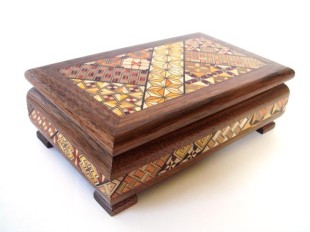
The intricate parquetry of yosegi zaiku (Image: Wikimedia Commons)
As you peruse the many gift shops around Hakone, you are sure to come across the region’s most recognizable handicrafts. Yosegi zaiku is a woodworking technique that has its origins in the wide variety of trees that grow in the region, which includes cedar, mulberry, and camphor. “Yosegi” means, roughly, to gather wood, and “zaiku” speaks to the detailed work that goes into making this parquetry: craftsmen cut long strips of the different types of wood and glue them together into the desired pattern. A wood plane is then used to shave off sheets of what looks almost like wallpaper, and which can be combined to make elaborate and variegated patterns. These sheets are then glued to any number of objects—one of the most popular souvenirs are “puzzle boxes,” but the possibilities are limitless, as are the patterns that truly skilled yosegi zaiku artists can create. While it is a bit of a walk from the Iriuda Station on the Hakone Tozan Line, a yosegi zaiku museum can provide the curious with a deeper look into Hakone’s native art. (Ashigarashimo-gun, Hakone-machi, 84 Yumoto)
If you fancy something a little more strenuous than strolls or museum-hopping, Hakone also offers some excellent places for hiking as well. It is possible to hike your way into the Hakone area from trailheads off of the Odakyu Line, but a simpler excursion follows the course of Hakone Ropeway. After getting off the cable car at Sounzan Station, you can find the trail head about 50 meters from the station building. The trail makes its way up a moderately steep climb through light tree cover and sasa (bamboo grass) to the peaks of Mount Kami and Komagatake, making for panoramic views of the surrounding area. You can finish the hike at “Great Boiling Valley,” or Owakudani, an area that still steams and bubbles with sulfuric gases. It’s a fascinating area to explore in its own right, and you will probably have worked up enough of an appetite to eat a few “black eggs,” which have been boiled in sulfuric waters—fear not, though: it’s only the shells that are black, and the eggs are actually said to grant the eater an extra seven years of life.
Finally, however you get around during your stay, you should always keep an eye out for a glimpse of Japan’s most celebrated peak. When the skies are clear during the colder months, Mt. Fuji can be seen from several vantage points—according to some, it is one of the best ways to see the mountain, and adds one more reason that people continue to flock to Hakone year after year.
Getting Around Is Half the Fun
When you think of traveling in Japan, the first things that come to mind are the blazing speed of a bullet train or a crowded commuter car. But a trip around Hakone is an escape from the everyday, and you can feel the difference on the very first leg of your journey.
Boarding the Hakone Tozan Line train at Hakone Yumoto, you leisurely make your way into the forested hills and mountains. As your train wends its way up the scenic course, it stops on occasion to reverse direction—the Tozan Line is one of the few switchback trains in all of Japan—passing through tunnels and emerging onto views so stunning that even repeat visitors can’t help but marvel at them. Throughout the year, whether the area is alive with the hues of autumn or spring, or shrouded in fog, the surrounding landscape is breathtaking.
The Hakone Tozan Line is one of the most notable and enduring symbols of the Hakone experience, but it has now been given an upgrade with a new railcar: the Allegra 3000 series. Unveiled last month, the new car is environmentally friendly, offers a smoother ride, and provides passengers with an even better view of Hakone’s memorable scenery, thanks to its huge picture windows.
Of course, the switchback train is only part of what makes getting around Hakone such an unforgettable experience. Once you reach Gora Station, your journeys continue with a cable car, a ropeway gondola, and finally a sightseeing cruise that crosses the picturesque Lake Ashi, making a trip around Hakone an experience of relaxed variety. The areas around all of Hakone’s waystations offer a variety of museums, luxurious ryokan, restaurants, and hiking trails, all which can be explored at an easygoing pace, whether you’re passing through just for the day or for a long weekend. One particular spot that shouldn’t be missed is the Hakone Yuryo, a lovely inn that opened last year. Even if you’re not staying at the ryokan, you can stop in for a soak in the large public onsen or reserve one of 19 private onsen, many of which offer stunning views of the surrounding forests.
Hakone Suishoen Ryokan
Located in a former aristocratic villa, the Hakone-Suishoen Ryokan offers a rare experience of truly personalized luxury. From the attentive service that you will receive as soon as you enter the inn and expertly prepared meals, to relaxing spa treatments and a variety of hot spring baths and saunas, every element of your stay has been tailored to make your stay as pleasant as possible.
Each of Hakone Suishoen’s 23 rooms offers an entirely different experience. Whether you stay in the opulent and secluded splendor of the Negau Luxury Suite or in any other of the hotel’s finely appointed rooms, each room features a unique design and layout. What the rooms have in common are the private outdoor onsens, and an array of fully modern amenities, such as high-speed internet access and high-definition TVs. If you’re looking for a little more pampering, drop in at the Suishoen Spa for a full range of relaxing massage and beauty treatments, which will rejuvenate you, mind, body, and spirit.
Throughout the day you can partake of a tasteful array of seasonal delicacies. After a relaxing soak in one of Suishoen’s hot spring baths, you can begin your day with either a traditional Japanese breakfast set made from the bounties of the local land and sea, or a hearty Western-style breakfast that consists of seasonal fruit, yogurt, freshly baked bread, and the hotel’s signature soy milk omelets. Following a light lunch, a spectacular combination of tastefully chosen ingredients awaits you, in the form of a traditional Japanese gourmet kaiseki meal or teppanyaki meal, featuring the succulent flavors of grilled meat, vegetables, and seafood. And for a refreshing drink during the afternoon or a nightcap, the bar “Ito” offers elegance and a full range of wines, cocktails, and Japanese sake.
Hakone-Suishoen
Kanagawa-ken, Ashigarashimo-gun, Hakone-machi, Kowakidani 519-9
www.hakonesuishoen.jp/eng
Ryokan Enlightenment—Hakone Yuyado Zen
Mt. Fuji views and private onsens top the highlights at this charming Japanese-style inn
By Matthew Hernon
A deluxe hotel in a serene environment surrounded by luscious greenery and spectacular views of Mt. Fuji, Hakone Yuyado Zen feels like it is a million miles away from the hustle and bustle of city life, yet is located close enough to the center of Hakone, meaning the area’s top tourist sites are not too far away. In addition to the gorgeous scenery, the hotel also boasts spa facilities, a semi-open air bath in each room and a fine dining experience that includes some of the finest Japanese beef: Fujiyama wagyu.
Waking Up to Mt. Fuji
An early morning soak in a semi-open air bath with Mt. Fuji looming out on the horizon: It’s a truly majestic way to start the day. At Hakone Yuyado Zen there are four rooms with a view of Mt. Fuji (on a clear day anyway), two of them Japanese style, two Western style. Unsurprisingly these are the most popular rooms in the hotel. If they are booked up though you needn’t fret: there are five other rooms, all of which boast a calming view of the surrounding forest.
Every room in the hotel is designed to make guests feel as relaxed as possible. They are spacious, stylish and extremely comfortable. Inside them you have an illy espresso machine, a digital TV, a refrigerator full of drinks, free Wi-Fi, a wireless LAN connection and various other amenities that help to make your stay that much more pleasant.
Unquestionably the standout feature of each room though, is the semi-open air bath. Soothing and therapeutic, the natural sulphuric water from Owakudani (Great Boiling Valley) is said to be good for cuts, skin disease, fatigue, burns, stiffness and various other ailments. If your room tub isn’t quite big enough for the whole family, there is a more spacious bath on the first floor that can be reserved for private use.
Delectable Dishes with Local Flavor
As well as the private baths, there are also private dining rooms, meaning that guests can enjoy their meals in a secluded, quiet space without having to worry about noise coming from other tables or how much noise they make themselves.
Dinner is kaiseki style so you will want to leave yourself plenty of time to enjoy it properly. There are more than ten dishes in total, the majority of which are carefully created using seasonal vegetables and fresh fish caught directly from the bays of Suruga and Sagami. The highlight of the meal though, is undoubtedly the sumptuous Fujiyama wagyu: this Japanese beef can be prepared several ways, including shabu shabu style or as a sirloin steak, and is truly exquisite.
After all that, hopefully you will still have room in your stomach for more culinary delights the next morning. Breakfast is a traditional Japanese affair with carefully selected wild vegetables, seafood, rice and miso soup. A colorful array of dishes, it comes in a small, flower basket–like bowl. Breakfast is also served in a private dining room, looking out onto the green district of Sengokuhara. Other facilities at the hotel include a terrace lounge where you can relax with a drink while looking out at Mt. Fuji, and a café/bar with a variety of whiskies and brandies.
Address: 250-0631
Kanagawa-ken, Ashigarashimogun, Hakonemachi,
Sengokuhara 1245–96
Tel: 0460-84-2400
www.hakone-zen.com

